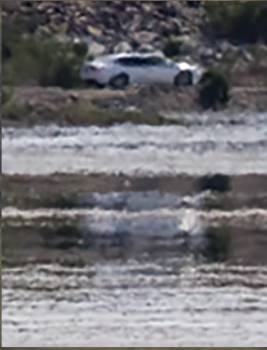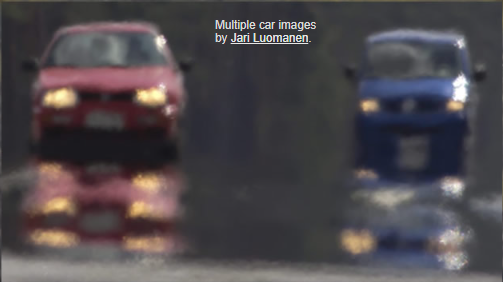Death Valley Mirage - OPOD
Death Valley Mirage - Exploring the Phenomenon
Mirages have long captured the fascination of both scientists and casual observers. These optical illusions create the illusion of objects or landscapes that are not actually present. One particularly intriguing mirage, known as the Death Valley Mirage, has been the subject of much study and discussion.
The Illusion of Reflections
Imagine a serene scene: a car parked near a shimmering body of water, perhaps for a relaxing picnic. However, this idyllic image is deceptive. The location is Death Valley National Park in California, a place known for its scorching heat and arid environment. The "reflections" that appear to be on the water's surface are actually an example of an inferior mirage.
Understanding Inferior Mirages
Inferior mirages, such as the one observed in Death Valley, occur when light is refracted between layers of hot and cool air. Traditionally, we associate these mirages with a single mirror-like reflection that appears to be on a bright body of water. However, there is more to their story than meets the eye.
Multiple Images and Topology Rules
A complete inferior mirage consists of multiple images, each with its own unique characteristics. The first image is inverted, appearing upside down. Below it, an erect image can be observed, followed by another inverted one, and so on. The order and orientation of these images are determined by strict topology rules.
The Intriguing Mirage of Steve Mattan
In the case of Steve Mattan's mirage in Death Valley, three or four images can be discerned. While the first image may appear upright instead of inverted, it is challenging to determine the orientation of the lower images. These variations in image orientation are not indicative of any rule-breaking but rather depend on the nuances of air temperature gradients.
Compression and Stretching Effects
The characteristics of an inferior mirage can vary depending on the air conditions. Some images may appear compressed into lines, while others are vertically stretched. Turbulent air can further complicate the mirage, causing certain images to be masked by wind-rippled "water." It is this dynamic nature of mirages that adds to their mystique and intrigue.
An Almost Ideal Mirage
An example of an almost ideal mirage can be observed in the miraging of oil storage tanks. The image orientations can be determined by examining the slope of the access steps. In this case, the sequence typically follows an inverted, erect, inverted pattern. However, even in this seemingly perfect mirage, there are still instances of image compression and stretching.
Exploring the Death Valley Mirage
The Death Valley Mirage serves as a captivating example of the intricate nature of atmospheric optics. By studying these mirages, scientists gain insights into the complex interplay between temperature gradients and light refraction. Additionally, these phenomena offer photographers and nature enthusiasts a unique opportunity to witness and capture the beauty of these elusive illusions.
Conclusion
Mirages continue to captivate our imagination with their ability to create stunning illusions in the natural world. The Death Valley Mirage, with its multiple images and intriguing characteristics, is a prime example of the complexity and beauty of atmospheric optics. By delving into the details of these mirages, we gain a deeper understanding of the fascinating interplay between light, temperature gradients, and perception. So next time you encounter a mirage, take a moment to appreciate the wonders of our ever-surprising atmosphere.

Mirages, Mirages
A tranquil scene. Car parked, perhaps for a picnic, near a cooling river or lake. We see its reflection where the water is smooth.
Not so. There is no cooling water. It is Death Valley National Park, California imaged by Steve Mattan. The camera looks across hot and dry land.
The 'reflections' are an inferior mirage. Inferior because they are below the car.
The 'reflections' bear closer inspection.
Images ©Steve Mattan, shown with permission

Inferior mirages, hot road or desert oasis mirages form by light refracted between lower hot air and upper cool air. We traditionally regard them as a single mirror 'reflection' apparently in bright water. The mirrored object is upside down. The 'water' is not thirst quenching. It is miraged sky.
That is only part of their story.
A more complete inferior mirage has many images. The first is inverted. Below is an erect image. Then another inverted one. And so on. Strict topology rules dictate what images can form and in what order.
Steve Mattan's mirage has three or four images. The first is maybe upright rather than inverted. It's hard to tell the orientation of the lower ones.
No rules are being broken. Depending on the nuances of the air temperature gradients, some images can be squashed into lines. Others are vertically stretched. Turbulent air might mask some as wind rippled 'water'.
An almost ideal mirage is below. Oil storage tanks are miraged and we can tell the image orientations from the slope of the access steps. Inverted, erect,inverted and so on.
Even here, some images compress, others stretch.
Image by Mark Evans.


Note: this article has been automatically converted from the old site and may not appear as intended. You can find the original article here.
Reference Atmospheric Optics
If you use any of the definitions, information, or data presented on Atmospheric Optics, please copy the link or reference below to properly credit us as the reference source. Thank you!
-
<a href="https://atoptics.co.uk/blog/death-valley-mirage-opod/">Death Valley Mirage - OPOD</a>
-
"Death Valley Mirage - OPOD". Atmospheric Optics. Accessed on December 22, 2024. https://atoptics.co.uk/blog/death-valley-mirage-opod/.
-
"Death Valley Mirage - OPOD". Atmospheric Optics, https://atoptics.co.uk/blog/death-valley-mirage-opod/. Accessed 22 December, 2024
-
Death Valley Mirage - OPOD. Atmospheric Optics. Retrieved from https://atoptics.co.uk/blog/death-valley-mirage-opod/.